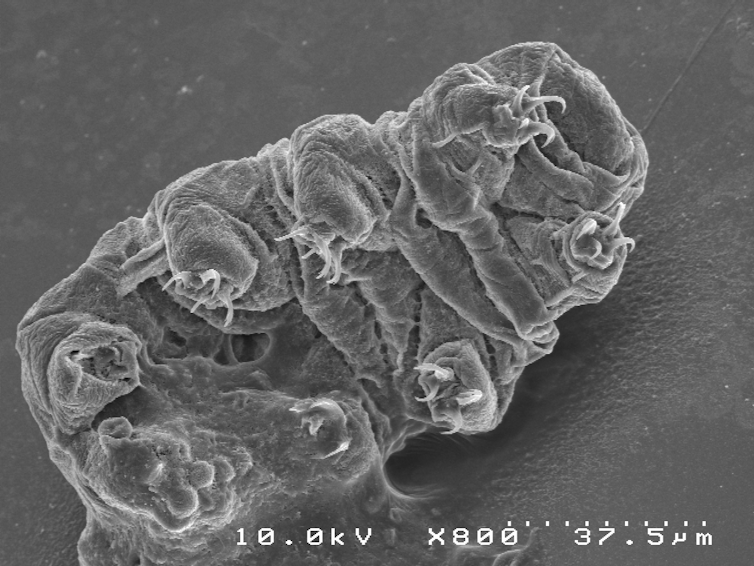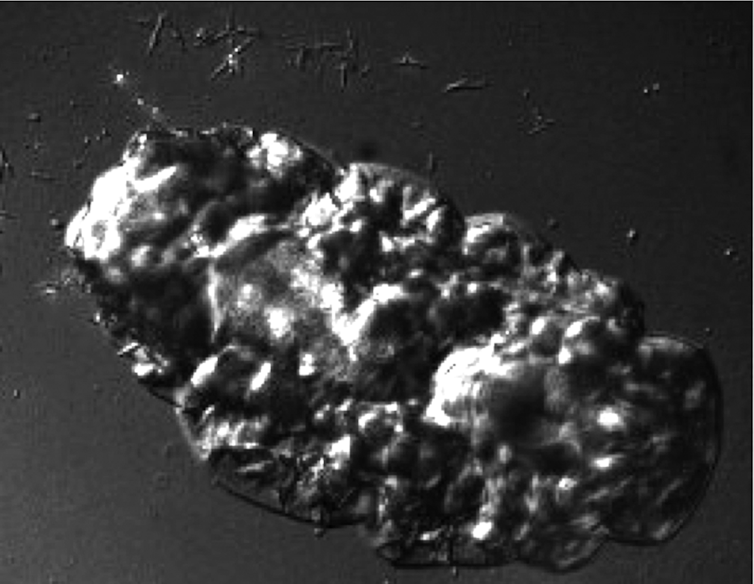The secrets of tardigrades, those cosmic Pokémons
They're clawed and mythologically beautiful. Tardigrades, microscopic invertebrates with a Pokémon-like appearance, are terrestrial creatures. But if life were to be discovered elsewhere, on another planet, we might well find them curled up warm, or cold, in extraterrestrial cocoons.
Michel Cassé, Commissariat à l'énergie atomique et aux énergies alternatives (CEA) - Université Paris-Saclay and Simon Galas, University of Montpellier

And with good reason. Thanks to their ability to survive in the most hostile conditions and adapt to the most extreme environmental fluctuations, these organisms have taken the art of survival to a whole new level. On Earth, tardigrades can withstand anything: even when frozen, boiled, dried out, irradiated, crushed or poisoned, they live on. In short, we're dealing with a cosmically privileged species. Let's not hesitate, then, to describe them as intelligent, since this quality is relative to the adaptive capacities of living beings. Far superior, in any case, to robots endowed with a much-maligned artificial intelligence.

Author, Author provided
Suspended life
What is the secret of this resilience? Tardigrades have several strategies which, when combined, enable them to perform a marvelous feat: literally come back to life after a period of suspended life in a living crystal state, known in science as the anhydrobiotic state. Their organisms can lose all their water when the environment dries out, leaving them with no metabolism. But, after rehydration, they come back to life! This is thanks to specific proteins and sugars that replace water in the body ( threose).
And that's not all. During their suspended state of life, tardigrades can be
subjected to extremely violent aggressions, such as those produced by X-ray irradiation. To counter this, proteins protect the DNA of these micro-organisms (they have also been identified, in the human body, as protective agents for kidney tissue).
Even so, these sleeping beauties can sometimes suffer damage. But they can repair themselves when the time comes, thanks to a set of enzymes that act like molecular DNA surgeons.
To put it simply, tardigrades can put their survival first:
- Almost total loss of water from the body, limiting attacks on DNA by water hydrolysis.
- The production of proteins capable of vitrifying the animal as it loses water. These proteins protect the animal from bacteria and yeasts that cause it to dry out.
- The production of DNA-protecting proteins acting as molecular umbrellas.
- The expression of enzymes that repair the damage accumulated by DNA during the awakening to life. To be able to resuscitate normally, tardigrades need to have kept their muscles in good working order. A molecular and sporting feat.
Tardigrades are also known for their ability to survive exposure to vacuum. This has been tested in the laboratory, but it was a space mission that finally demonstrated tardigrades' ability to withstand the hostility of the cosmos.

Author, Author provided
Vacuum of space and radiation
It was September 2007. ESA's Foton-M3 mission and its Biopan-6 platform exposed tardigrades to the vacuum of space and to ionizing, UV and cosmic solar radiation for 10 days in low-Earth orbit. During the experiment, the tardigrades were exposed to radiation levels of up to 7,000 kilojoules/square meter, a thousand times higher than at sea level. Despite these extreme conditions, the tardigrades were able to recover normal activity after their return to Earth, and their descendants are still being bred in laboratories.
Scientists are always surprised when organisms experimentally subjected to hostile environments that no longer exist on our planet, or are inaccessible to living organisms, resist them in spite of everything. In the latter case, the question of the origin and evolution of these extreme resistances often becomes a fundamental one. Today, tardigrades have demonstrated to scientists their incredible capacity to withstand normally inaccessible stresses. For example, they have survived exposure to pressures of up to 7.5 GPa (Ono et al., Journal of Physics: Conference Series 2012; 377: 012053-6p.; URL:). This pressure corresponds to that prevailing at a depth of 180 km in the Earth's mantle. Classically, proteins lose their secondary structure, and therefore their function, at a pressure of 2,000 MPa, and bacteria known to be the most robust to stress, such as Deinococcus radiodurans are able to withstand a pressure of just 600 MPa.
Back to the distant cosmos. A publication, "Earth-like and tardigrade survey of exoplanets", clearly indicates that tardigrades in their living or anhydrobiotic state are likely to survive in the environmental conditions of exoplanets selected on the basis of their degree of physical and chemical similarity to those of Earth. Of the 1,000 known species of tardigrades, some are more resistant to stress than others.
A grand voyage into the cosmos
Even if the possible survival of Tardigrades on these exoplanets is conceivable, they still need to get there. The question of whether tardigrades could survive a trip into the cosmos has been assessed. This is not a theoretical possibility: with the many objects that leave and return to Earth, tardigrades may well be able to take part in these human-organized journeys, and thus create a new evolutionary space for their species.
A final open question for the long journey: it has been observed that tardigrade DNA undergoes fragmentations that accumulate over the course of time spent in anhydrobiosis. Even if these DNA alterations are repaired by tardigrades when they wake up by rehydration, the question of the insertion of foreign DNA molecules during the DNA repair process raises the question of the possibility of the acquisition of foreign genome fragments and therefore of species modification. This particular acquisition process is known as horizontal gene transfer (HGT), and enables the evolution of certain genomes without the need for sexual reproduction (Vertical Gene Transfer).
![]() On earth, under the earth and in the sky, tardigrades officiate and toil, and we send our likely successors our compliments.
On earth, under the earth and in the sky, tardigrades officiate and toil, and we send our likely successors our compliments.
Michel Cassé, Astrophysicist and writer, Commissariat à l'énergie atomique et aux énergies alternatives (CEA) - Université Paris-Saclay and Simon Galas, Professor of Genetics and Molecular Biology of Aging, CNRS - Faculty of Pharmacy, University of Montpellier
The original version of this article was published on The Conversation.